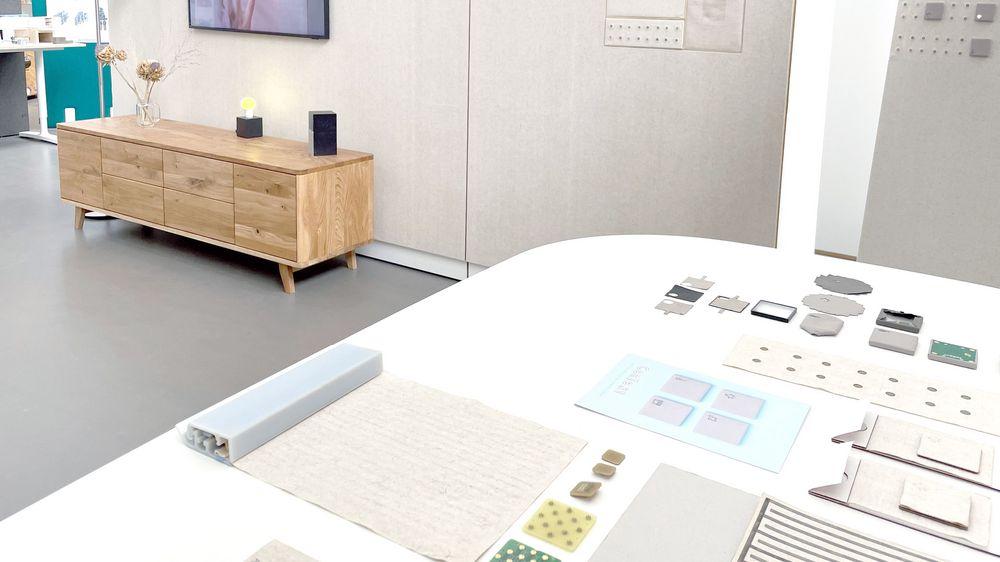Smart Home: Textile-based solution for seamless integration of IoT devices
A growing number of people are equipping their homes with smart, networked devices. However, the required connections are not always located where they are needed. The solution: smart textile surfaces that make walls and floors in the living area usable for cable-based power supply and communication. The innovative technology was developed by a consortium led by the German Research Center for Artificial Intelligence (DFKI) in the ConText project funded by the German Federal Ministry of Education and Research (BMBF).
There are many ways to make living environments intelligent. Thanks to the so-called Internet of Things (IoT), living objects can be connected with each other in such a way that they make our everyday lives easier in many ways. However, private households generally lack comprehensive low-voltage and communication connections to install IoT components such as temperature sensors, microphones, or light signals where they are needed. As a result, the devices usually operate on batteries and wireless technologies, which makes them susceptible to interference and failures.
Textile-based power supply, communication, and interaction
But how can the desire for creativity and flexibility in the use of smart home systems be met while at the same time dispensing with unfavorable energy supply and data communication? This was the question addressed by a consortium of industry and research partners in the ConText ("Connecting Textiles") project, which has now been completed. Inspired by the possibilities of smart textile materials, such as those already used in the manufacture of smart clothing, the partners investigated the potential of electronic textiles for cable-based low-voltage power supply and communication in indoor spaces. In an exploratory and use-oriented process, they developed an infrastructure that takes advantage of wired connections while integrating invisibly into textile surfaces. The so-called Connecting Textiles not only enable the flexible attachment of actuators and sensors in living areas by means of freely positionable patches, but also power supply and communication with smart home systems. In addition, the developed infrastructure provides haptic interaction modalities for intuitive control of IoT devices.
Demonstrators provide infrastructure via textile wallpaper
Demonstrators produced in the project implement the Connecting Textiles using a wallpaper as an example. The wallpaper consists of several layers: a magnetic backing layer that increases the adhesion between the patches and the wallpaper, a functional layer with woven-in conductor tracks that distribute the current vertically through the wallpaper, and a decorative top layer. To create the conductive traces, the partners investigated various woven and non-woven materials, such as those used today for standard wallpaper, as well as different processing techniques, including screen printing and weaving. Woven samples proved to be the most suitable for the functional layer due to their comparatively high conductivity. The electrical contacting of a wallpaper strip is made via the baseboard, which also connects adjacent wallpaper strips to enable large-area applications. The strip also contains the necessary electronics as well as functions that monitor the current flow to detect possible damage to the wallpaper or incorrectly applied strips.
User-oriented development of intuitive interaction elements
Functional patches serve as the central interaction elements of the Connecting Textiles, which can be flexibly attached to the wallpaper either with the help of magnets or by means of microneedles mounted on the back. The patches can either contain an IoT functionality, e.g., a sensor, or connect one or more IoT devices to integrate them into the smart home system. Control and configuration of the devices can also be done directly on the wallpaper via an additional interaction patch fabricated by screen printing on textile. Pattern recognition software captures the basic patterns of gesture interactions and allows control gestures and interaction sequences to be defined by the user. The interaction concept was developed and evaluated in the project in a participative way with the direct involvement of users.
Dr. Serge Autexier, ConText project manager at DFKI's Cyber-Physical Systems research department: "Thanks to the commitment and very good collaboration of the project partners, we have succeeded in demonstrating the feasibility of Connecting Textiles as a flexible, adaptable and easily configurable interaction medium that can be seamlessly integrated into Smart Homes. This not only opens up new possibilities for the confection of functional textile surfaces, but also for the development of novel IoT applications and the creative design of personalized human-environment interaction beyond the application context of home environments.”
One of the demonstrators developed in the project is integrated into the infrastructure of the Bremen Ambient Assisted Living Lab (BAALL) of DFKI as part of the Smart Home environment.
ConText was funded by the German Federal Ministry of Education and Research (BMBF) from July 1, 2019 to Dec. 31, 2022.
Project partners included:
- DFKI - Research Department Cyber-Physical Systems, Bremen
- DFKI - Research Department Interactive Textiles, Berlin
- Robert Bosch GmbH, Renningen
- German Institutes for Textile and Fiber Research Denkendorf (DITF), Denkendorf
- Fraunhofer Institute for Manufacturing Technology and Applied Materials Research (IFAM), Bremen
- Norafin Industries (Germany) GmbH, Mildenau
- Peppermint Holding GmbH, Berlin
- Innovative Living Institute GmbH & Co.KG, Mülheim an der Ruhr (subcontracted)
German Research Center for Artificial Intelligence



